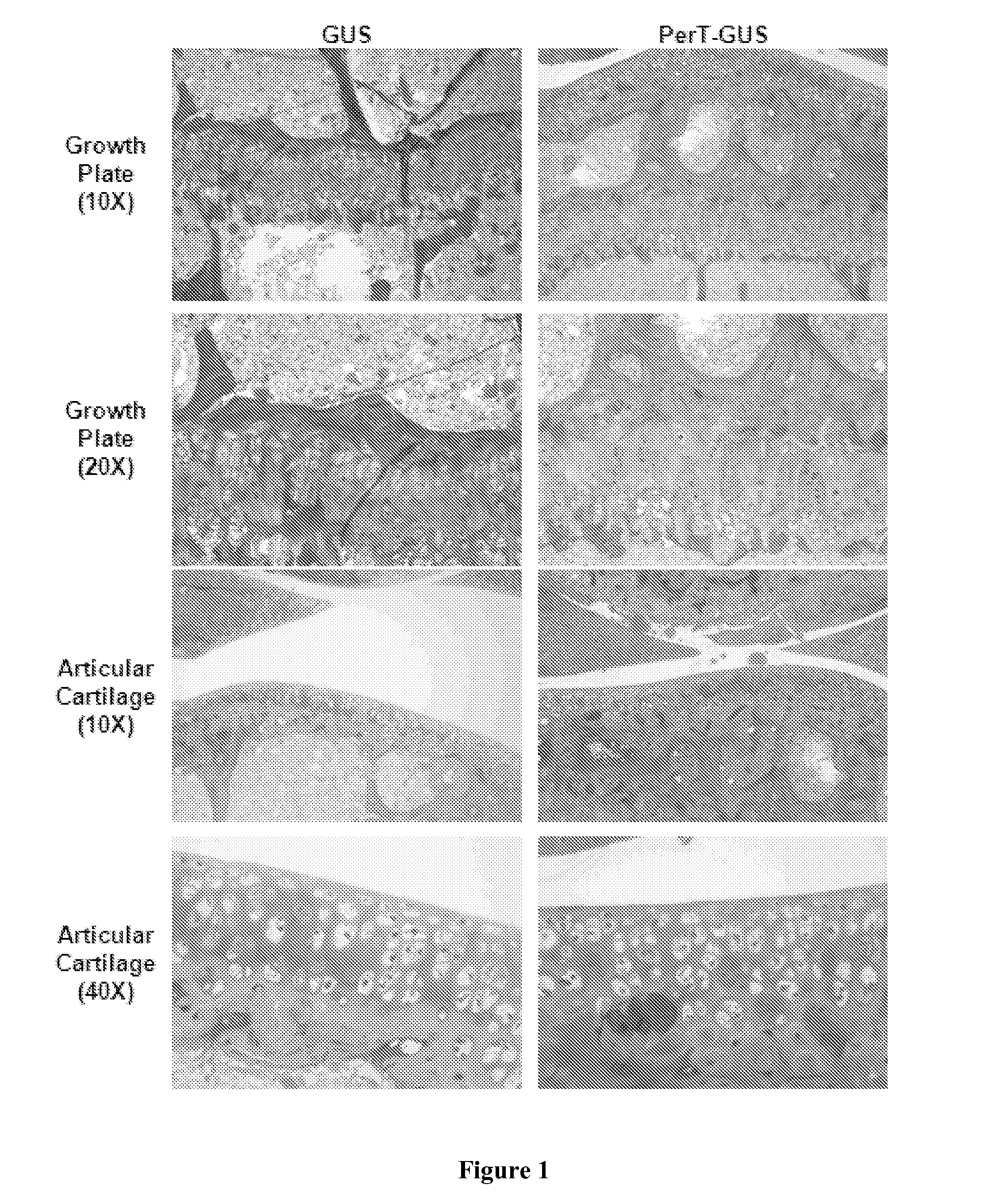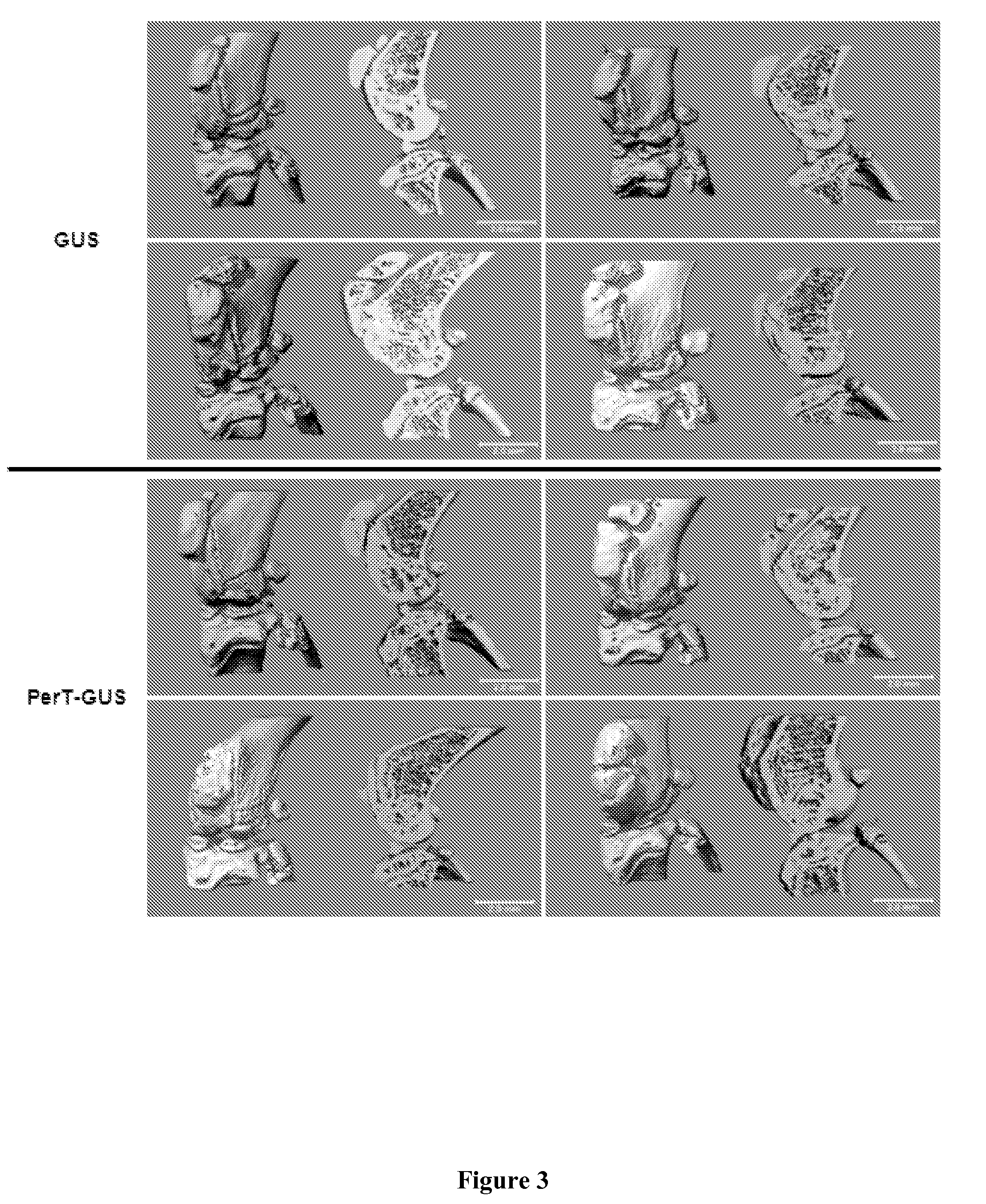Enzyme replacement therapy for treating MPS vii related bone lesions using a chemically modified enzyme
a technology of enzyme replacement therapy and mps vii, applied in the field of mucopolysaccharidose treatment, can solve the problems of limited clearance of gag storage material in bone, deterioration of clinical manifestations, and collapse of intravenous injections or infusions, and achieve the effect of improving bone mineral density
- Summary
- Abstract
- Description
- Claims
- Application Information
AI Technical Summary
Benefits of technology
Problems solved by technology
Method used
Image
Examples
example 1
[0063]Growth Plate and Articular Cartilage Histology
[0064]Growth Plate: The resting, proliferative, and hypertrophic zones of the growth plates in GUS and PerT-GUS treated mice contained enlarged and vacuolated cells (FIG. 1). Resting and proliferative zonal chondrocytes appeared larger in size in GUS treated mice compared with PerT-GUS treated mice. The growth plate was thicker and less organized in GUS mice. The normal columnar structure of the proliferative zone was also better preserved in PerT-GUS treated mice compared with GUS treated mice.
[0065]Articular Cartilage: Cells of the articular cartilage and meniscus were enlarged and vacuolated in both GUS and PerT-GUS treated mice. The articular cartilage chondrocytes were moderately smaller in PerT-GUS treated mice than in GUS treated mice. Cells in the meniscus of PerT-GUS treated mice contained noticeably less storage material compared with meniscal chondrocytes in GUS treated mice.
example 2
[0066]Quantitative Histopathological Analysis
[0067]To assess the morphology of the growth plate and articular cartilage in GUS and PerT-GUS treated MPS VII mice, the Inventors measured the thickness of the cartilage layer in the growth plate and articular cartilage, the cellularity in the articular cartilage and proliferative zone of the growth plate, a cross-sectional area of chondrocytes in the articular cartilage and proliferative zone of the growth plate as an estimate of cell volume, the mean number of cells aligned in columns perpendicular to the growth plate, and the ratio of the perimeter of the growth plate to its length as an indication of the amount of irregularity in the morphology of the growth plate (FIGS. 12 and 13).
[0068]These measurements supported our histological observations. The thickness of the articular cartilage in GUS and PerT-GUS treated mice was similar, however the growth plates in GUS treated MPS VII mice showed a trend towards increased thickness compar...
example 3
[0069]Micro-CT and Radiographic Findings
[0070]Micro-CT analysis of the bones of the knee joint (FIG. 3) and spine (FIG. 4) of GUS and PerT-GUS treated MPS VII mice showed that both GUS and PerT-GUS treatments significantly reduced the exophytic bone formation and cortical bone thickening which is seen in untreated MPS VII mice. Micro-CT scans also provided the (BMD) of the bones of the knee joint. GUS treated mice had a mean BMD of 459.11±9.59 mgHA / ml, PerT-GUS treated mice had a significantly lower BMD 444.86 mgHA / ml (p<0.05). This reduced BMD is evident in leg X-rays of GUS and PerT-GUS treated MPS VII mice (FIG. 5). Measurement of the thickness of the femur at its midpoint showed that the femurs of GUS treated mice remained abnormally thick (1.25±0.29 mm) compared with the femurs of PerT-GUS treated mice (1.13±0.25 mm; p<0.05). However, tibia length is similar in both GUS (1.60±0.04 cm) and PerT-GUS (1.63±0.03 cm) treated mice.
[0071]Long Term Protocol: Effects of Long-Term Treatm...
PUM
| Property | Measurement | Unit |
|---|---|---|
| time | aaaaa | aaaaa |
| time | aaaaa | aaaaa |
| pH | aaaaa | aaaaa |
Abstract
Description
Claims
Application Information
 Login to View More
Login to View More - R&D
- Intellectual Property
- Life Sciences
- Materials
- Tech Scout
- Unparalleled Data Quality
- Higher Quality Content
- 60% Fewer Hallucinations
Browse by: Latest US Patents, China's latest patents, Technical Efficacy Thesaurus, Application Domain, Technology Topic, Popular Technical Reports.
© 2025 PatSnap. All rights reserved.Legal|Privacy policy|Modern Slavery Act Transparency Statement|Sitemap|About US| Contact US: help@patsnap.com



